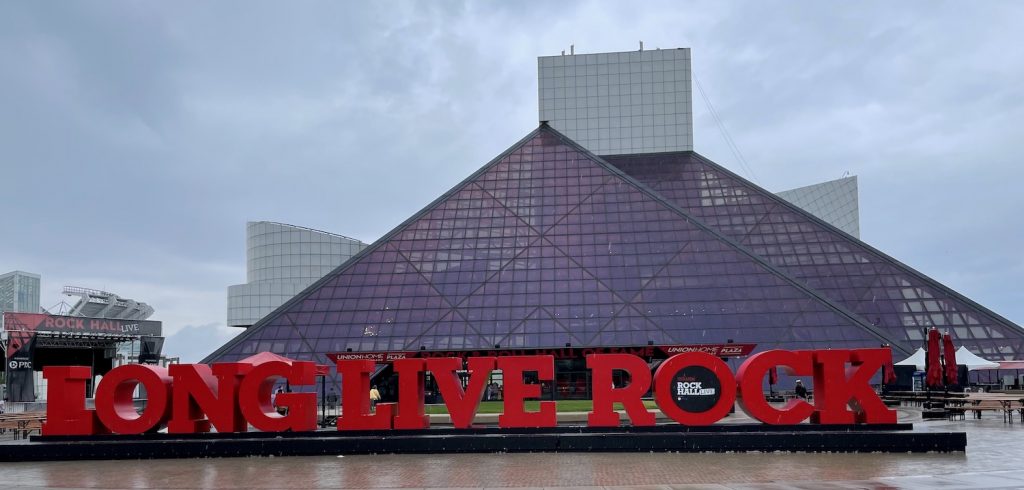
When it was first announced in 1983, I thought that the establishment of a Rock and Roll Hall of Fame was a ridiculous, maybe even terrible, idea. Music, I felt, should not be quantified in absolute terms. A band or artist that I love might be one that you despise, and vice versa. Who is to say that one artist deserves to be honored definitively with entry into a “Hall of Fame” while another should be shunned?
I have my own personal music hall of fame—the artists that have meant the most to me throughout my life, the ones whose records I play and whose concert tickets I have craved—and you have yours. I didn’t need a committee to tell me who belonged in rock’s top tier and who didn’t.
Music isn’t like sports, I reasoned. It’s much easier to decide which baseball or hockey player should be a Hall of Famer—there are statistics in place to determine that one is a better player than the other. Not so in music—the fact that an artist scored a string of Top 10 hits 50 years ago doesn’t necessarily make that artist better than one who wasn’t a commercial success but proved to have a massive influence on others.
Nor did it work the other way around—there are many artists adored by critics that never caught on with the masses. Should they be in a Hall of Fame if they are not famous? Some of my favorite artists of all time were neither famous nor influential! On the other hand, there are more than a few artists that have been inducted into the Rock Hall that you couldn’t pay me to listen to. And I get paid to listen to music!
As a music journalist, I began writing about my doubts as soon as the Rock Hall became an entity. The pieces I published always stirred up controversy among the various publications’ readers, and still do, but they had no impact whatsoever on what the Hall of Fame did (nor would I expect them to). I write about the Rock Hall because, it turns out, the Rock Hall pisses off a lot of people.
Related: We’ve come up with a list of 100 great artists the Rock Hall continues to ignore
But first, what exactly is the Rock and Roll Hall of Fame? And what, for that matter, is rock and roll? (As an aside, I’ve always preferred the spelling rock ’n’ roll, but I’ll go with their official spelling here.)
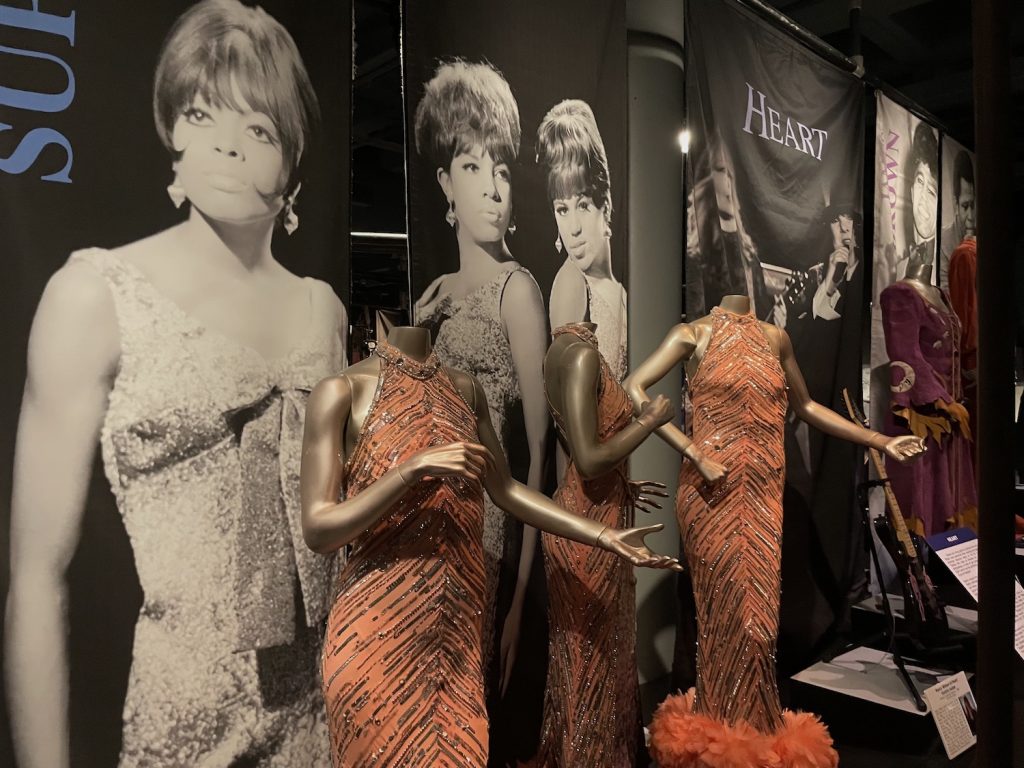
According to its website, in part, “Rock and roll is a diverse and inclusive art form that mirrors and shapes the times. Artists have been a voice of change and advocates for social justice for generations and the Rock and Roll Hall of Fame shares this through our intentional curation of exhibits, programs, and outreach. The Rock Hall values all by embracing talents, perspectives, and experiences. We intentionally foster a diverse and equitable environment that encourages creativity and innovation by valuing, empowering, and respecting all people.”
OK, that still doesn’t explain exactly what it’s about but it’s a start. To add a little to that, beginning in 1986, the Rock and Roll Hall of Fame—at that point only an institution based in New York City, without an actual building fans could visit—began inducting artists deemed particularly substantial. The process involved a select committee comprising music industry executives, journalists and rock radio bigshots, and a handful of artists, meeting annually to decide who deserved nomination. Once that list was compiled, a larger group of several hundred individuals involved in the music community voted on the ones they felt should be inducted, and every year a new “class” of artists entered the hallowed Hall.
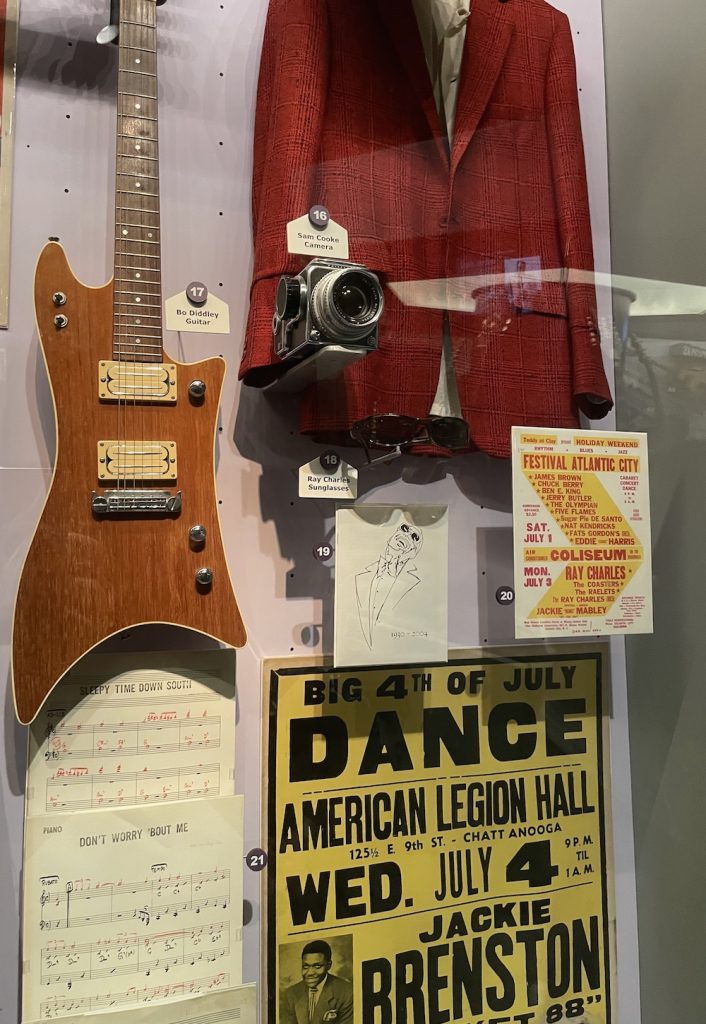
For the first several years, it was pointless to argue over any of its inductees: Elvis Presley, Little Richard, Buddy Holly and Chuck Berry were among the first year’s choices. Within a few years, the Beatles, Bob Dylan, the Beach Boys and the Supremes were in. Then, in time, the definition of “rock” expanded to encompass artists falling not only into rock’s many subcategories, from singer-songwriter to heavy metal to soul to punk, but into other related genres: Reggae, hip-hop, country and even jazz artists found their way in.
By that time, however, some rock fans were becoming angry: Why is that one inducted but not my favorite?! That artist isn’t even rock!
I continued to write about the topic, giving voice to those fans whenever I could. Then, in 1992, much to my surprise, I received a phone call from the woman who was the CEO of the Rock and Roll Hall of Fame Foundation. Apparently, someone there had been reading my criticisms. How would I like to be on the nominating committee? Perhaps instead of complaining, I could contribute. (She didn’t really say that, but I knew that was the real reason I was invited.)
I took her up on her offer and soon found myself in a room surrounded by some of the biggest movers and shakers in the business. For a few hours we tossed around the names of newly eligible artists—the only real guiding criterion was that an artist had to have recorded for the first time 25 or more years earlier—and came up with a group of nominees. Some I agreed with; others I wasn’t too keen on, but now at least I saw from the inside how it worked.
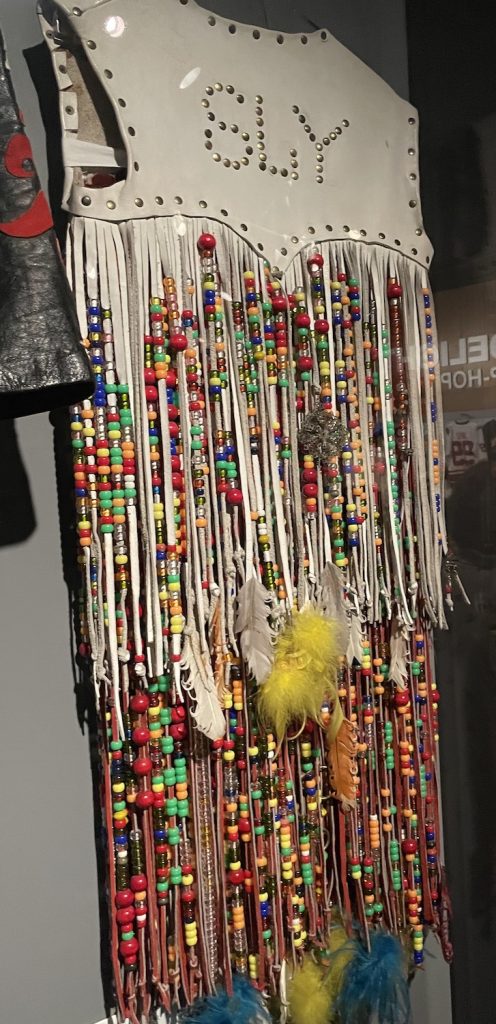
And one thing I discovered, at that meeting, was just how much music biz politics determined who would be nominated. When word got out among readers of the publication I was then editing that I was newly appointed to the nominating committee, I was besieged with letters (email was still coming into wider use; social media didn’t yet exist), passionate pleas intended to convince the committee to nominate this artist or that. Fans of one band—very popular but loathed by most critics—even put together a petition with 5,000 signatures and sent it to me, asking me to present it to the committee as proof that the band deserved induction. I lugged that pile of paper with me, presented it to the committee, and there was laughter all around the room. “Do you personally think that they should be nominated?” I was asked by one prominent board member when the chuckles died down. “I’m not much of a fan,” I replied, “but 5,000 people signed a petition so I think they’re worth considering.”
End of discussion. That particular band would not be nominated for another two-and-a-half decades—at which time they were inducted right away.
Watch Talking Heads perform “Life During Wartime” at the 2002 induction event
Another conversation revolved around the possible nomination of a certain 1950s doo-wop group. One board member was adamant that they should be nominated, but the person running the show at the time nixed the choice: “They won’t sell a single ticket to the dinner!” was the excuse, referring to the Hall of Fame’s annual induction ceremony at New York’s Waldorf Astoria hotel. (That group was inducted several years later.)
Related: The Moody Blues were inducted in 2018, decades after they first became eligible
Several months after that meeting, I was approached to write about the nomination process for a major music trade magazine. I still didn’t think anyone really noticed or cared what I had to say, but when I showed up at the following year’s nomination meeting, one very famous record producer proved me wrong. He had made a couple of dozen photocopies of my article and passed them around the room in order to show that there was a traitor in their midst, someone who sat in on the meetings while believing the whole thing was a sham.
“You’re calling us all assholes!” he bellowed, pointing a finger in my direction. “No,” I replied. “I’m calling you all hypocrites.”
I was not invited back the next year—or ever again. I had dared to open the lid on what went on behind those closed doors and that wasn’t appreciated.
Related: 100 more Rock Hall omissions
It’s important to note that up until that time, there was still no actual, physical Rock and Roll Hall of Fame. It was just a concept. It wasn’t until 1995 that the Rock and Roll Hall of Fame museum opened in Cleveland, Ohio. (Why Cleveland? That’s another debate for another time.) The futuristic, five-story, I.M. Pei-designed structure was where all of the inductees would be acknowledged, but it went much further than that, attempting to honor—through exhibits, events, films and more—the entire history and breadth of the music. It has since become a major tourist attraction, drawing hundreds of thousands of visitors each year.
In the quarter-century since the Hall of Fame itself opened its doors, I have continued to write about the “other” Hall of Fame, the group in New York that decides who belongs and who doesn’t. I still critiqued the flawed nomination/induction process with some predictability, although I had yet to set foot inside of the building in Cleveland.
Watch: Mick Jagger induct the Beatles into the Rock Hall
That finally ended in July 2021. With the Covid-19 pandemic having subsided somewhat, my wife suggested it might be nice to take a little trip. Like most people, we’d stayed close to home for the past 16 months, and now we were ready to get out of town, fly on an airplane again, stay in a hotel, see something we hadn’t seen before. Foreign travel was out—most countries still weren’t open for travelers—and besides, we just wanted to do something quick and fun. “How about the Rock and Roll Hall of Fame?” I suggested. Plans were made for an overnighter to Cleveland, with our 25-year-old son joining us. Finally, some 35 years after it was created, I’d see the real Rock and Roll Hall of Fame.
In my writings on the Hall, I’d always emphasized that the New York-based board and the Cleveland museum were largely two distinct entities. One didn’t necessarily seem to have anything to do with the whims of the other. An artist might be inducted into the Hall of Fame but have close to zero representation in Cleveland. Conversely, an exhibit at the museum might focus on an artist that has not been (and may never be) nominated by the New York committee. An artist could also perform at the museum without having been inducted.
I was very curious to discover how Cleveland saw rock history, and how that would differ from the way the NYC folks did.
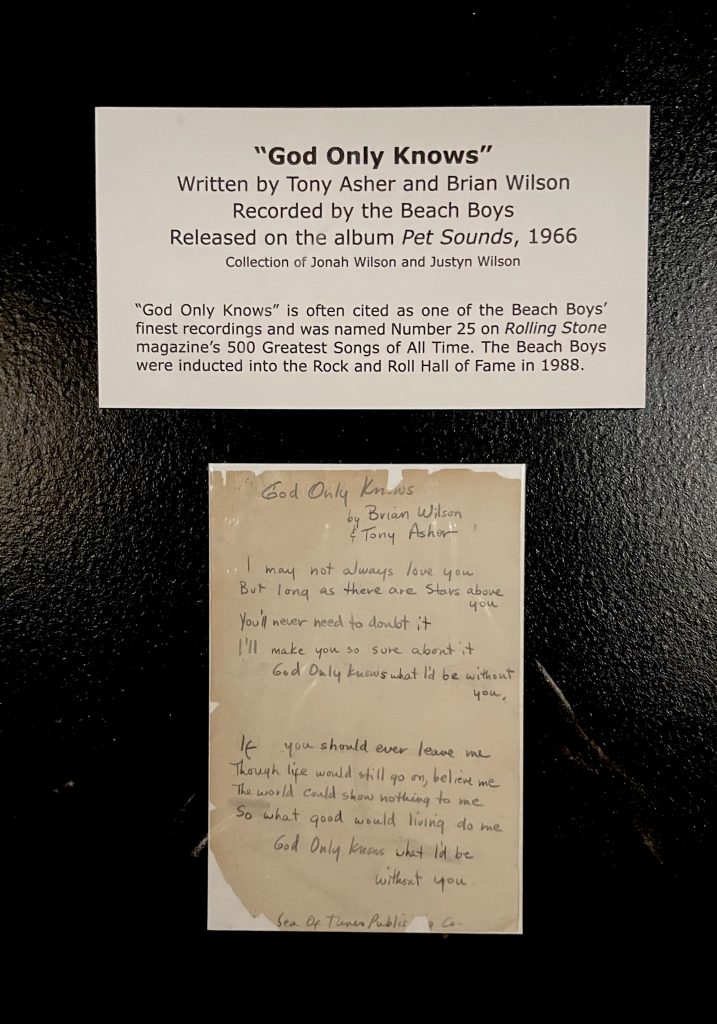
It’s an impressive sight, the museum, jutting out this way and that and welcoming visitors with its seven-foot-tall “Long Live Rock” sculpture in front of the building, situated in downtown Cleveland near the shore of Lake Erie. Upon entering, one immediately notices the equally king-sized gift shop to the right and a smallish café to the left. Visitors are instructed by the ticket taker to start downstairs—it’s even called Level 0—in the Ahmet Ertegun Main Exhibit Hall. It is here that most visitors will likely spend the bulk of their time, ogling the thousands of artifacts that once belonged to rock’s greatest artists. Here are the guitars, keyboards and drums, the colorful, exaggerated costumes, the handwritten lyrics and letters and photos and…stuff.
A section titled “It’s Been Said All Along: Voices of Rage, Hope & Empowerment” accentuates rock’s rise as a music of revolt, or at least the memorabilia associated with it: a James Brown jumpsuit, an Aretha Franklin dress, lyrics to a rap anthem by Public Enemy.
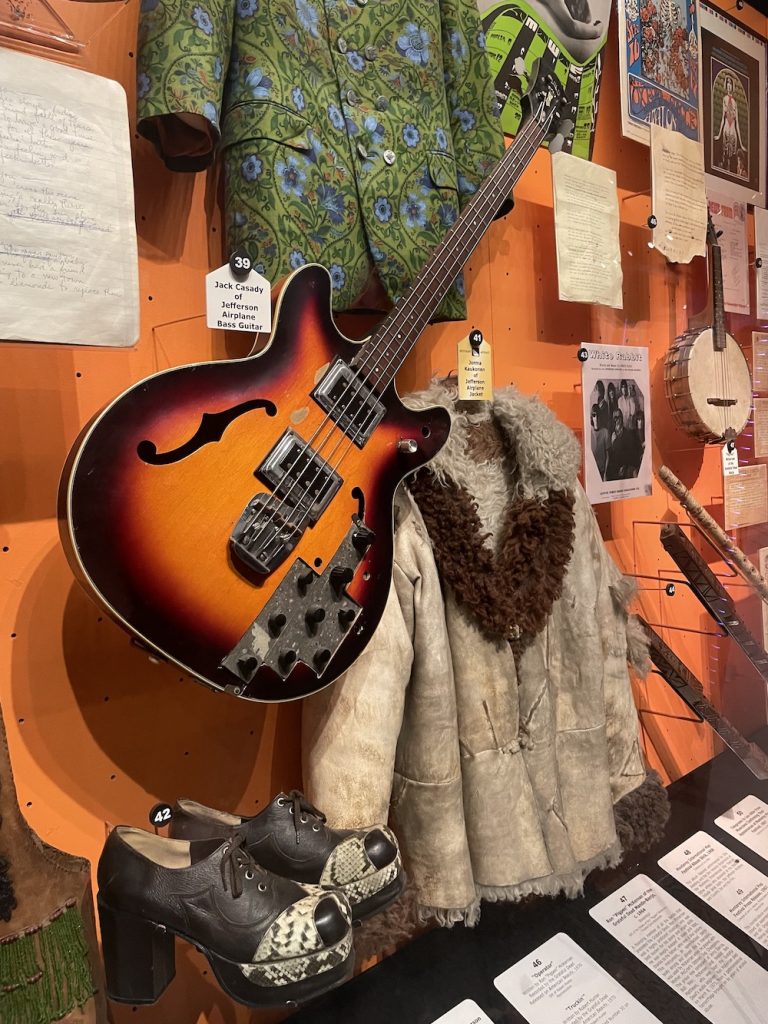
Other featured exhibits on Level 0 include prints of photos taken by Rolling Stone’s Baron Wolman—among them pics you’ve likely seen many times before, of Hendrix, Joplin, Jagger, Garcia, etc. An impressive tribute to the early influences on rock and roll, another focusing on Elvis, and one putting the Beatles and Stones in the spotlight are fantastic. Yet another sizable section on this floor breaks down rock’s impact by city, displaying tons of items associated with artists that came up in Memphis, New York, L.A. and San Francisco, London and Liverpool, etc.
[It should be noted that the museum’s curating team regularly introduces new exhibitions throughout the year. To see which Special Exhibits are on display now, click here. In addition, it rotates many of the items in its extensive collection.]
There’s “Rapper’s Delight,” which puts the hip-hop movement into perspective. It is on this floor that you’ll also find all the cool artifacts from the likes of David Bowie, Bruce Springsteen, Guns N’ Roses and many others.
One questionable inclusion—albeit one that seemed to attract plenty of gawkers the day we attended—is devoted to the Super Bowl halftime shows of the past 50 years. If you want to be reminded that the shows that once featured Prince, the Stones and the Who now star Katy Perry, Beyoncé and The Weeknd, this is the place for you. (This exhibit has been removed since this article was written.)
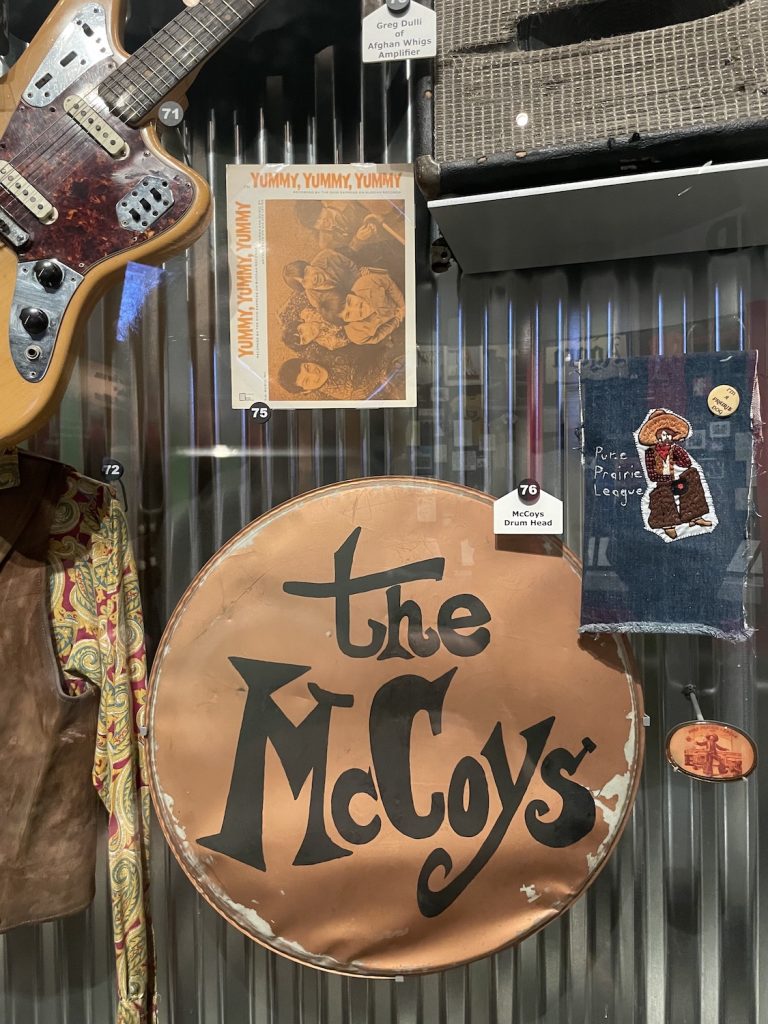
The city of Cleveland gets its own nod in a smallish exhibit, although 1950s disc jockey Alan Freed, who came to prominence in Cleveland and supposedly gave rock and roll its name (he didn’t really—the term dates at least back to the 1920s)), is barely acknowledged.
Nor, for that matter, does the Ahmet Ertegun Main Exhibit Hall do much to recognize Ahmet Ertegun, the Atlantic Records (and Rock Hall) cofounder after whom the entire floor is named.
Another curious inclusion on Level 0 is titled “Right Here, Right Now,” which aims to convince visitors that rock is still viable and vital. If you’re a classic rock fan who lived and breathed the music first-hand back in the day, you may wonder why the Rock and Roll Hall of Fame is devoting space to outfits belonging to Lady Gaga and Billie Eilish, or why the music of a band called Panic! at the Disco is blaring over the sound system. But if you brought your kids or your grandkids, ask them: They may not have a clue who Moby Grape or the Zombies were, but they may beg to linger a bit longer in the only section of the Hall that features artists they listen to.
Will their favorites—bands you’ve never heard of—someday get inducted? There’s a very good chance of that, so be patient, Mom and Dad. You had your fun, now it’s their turn.
Related: Meet the 2023 inductees
Two conversations I overheard in this part of the building served to remind me that the Rock and Roll Hall of Fame museum is intended to be a family attraction, and a teaching experience, not just a place for baby boomers to reminisce. The first one took place in a corner where the British ’60s band the Small Faces get their due. “The Small Faces? I never heard of them,” said one guy in his late twenties to a friend. He then stopped to read about the band’s history. “Ohh,” he exclaimed, “that’s where Rod Stewart got his start!” Well, not quite, but close enough.
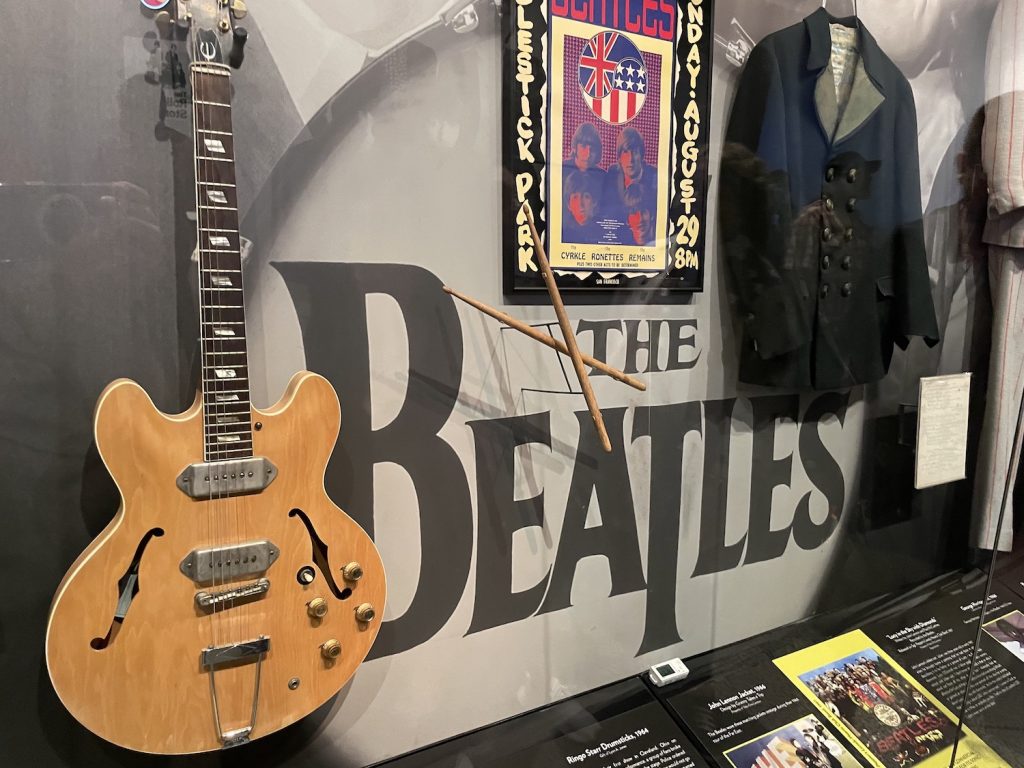
At another point, in a Beatles section, a father fielded a question from his daughter, who looked about 10. “Why did the Beatles break up?” she asked him. “Well,” he said, “their lead singer married someone the others didn’t like.” Wrong on several levels, Dad, but it’s simply too late in the day to try to unravel that one.
As you ascend the escalators to the other levels, you might find that some are more worthy of your time than others. Level 2, The Garage, allows you to strap on a guitar or grab a microphone and be a future inductee. We skipped Level 2.
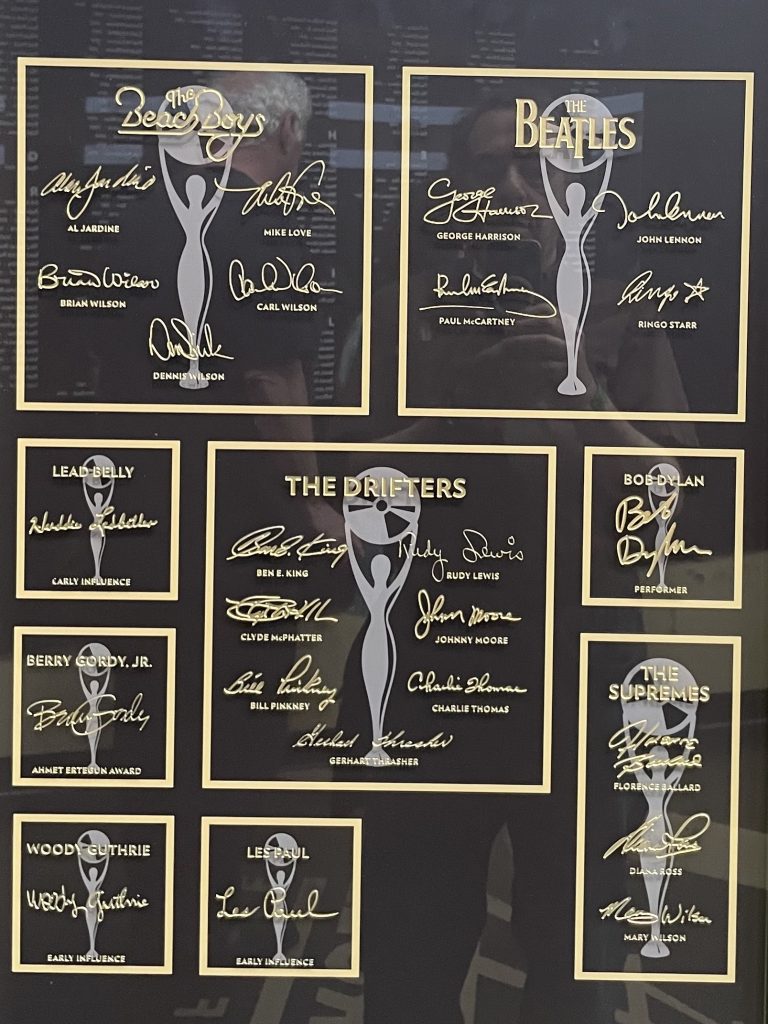
Level 3 is what it’s ostensibly all about, though it’s not that exciting to look at. This is where all of the inductees, numbering more than 300 when we attended in the summer of ’21, get name-checked on smallish plaques that list their names and display their signatures. The inductees are arranged year by year, beginning with the class of 1986. We are reminded that the latest class includes Depeche Mode, The Notorious B.I.G. and Whitney Houston, along with a few actual rock bands (T. Rex, Doobie Brothers, Nine Inch Nails). And right away we’re drawn back into that controversy about who deserves induction and who doesn’t. Maybe it’s best if we move on to Level 4, which is…
The Wall. Nothing but a recreation of Pink Floyd’s big white wall. You can sit on a couch here and look at the wall if you need a break. For us, time to hit the escalator.
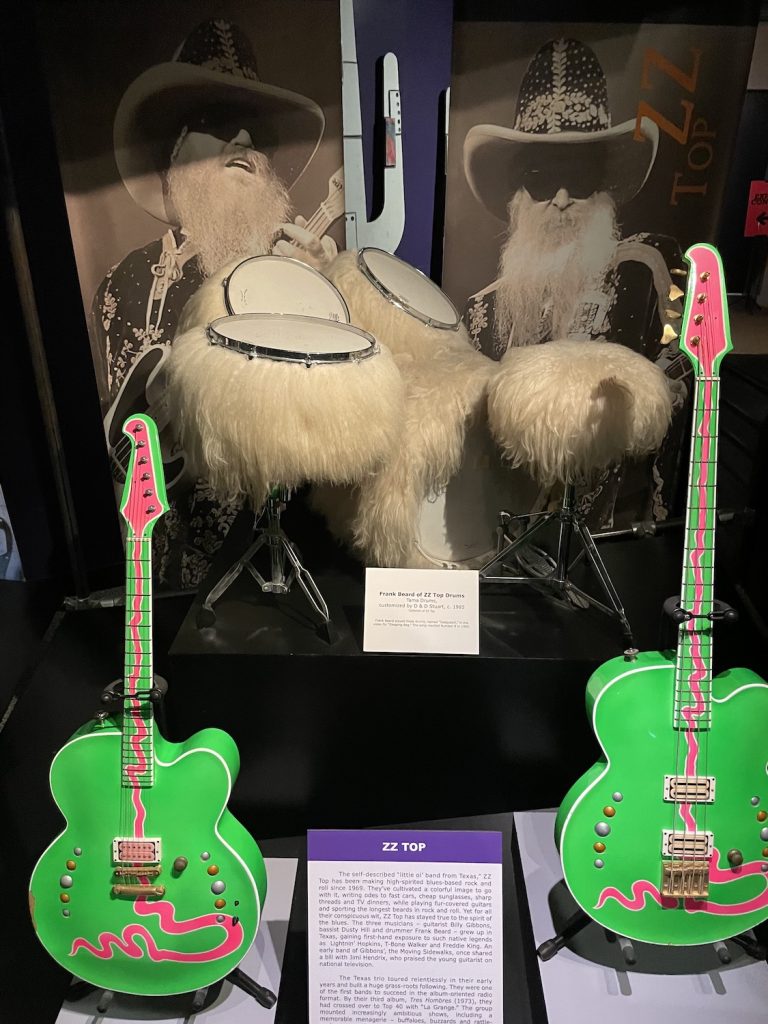
Level 5 is sort of a continuation of what we enjoyed in the basement, but specializing in instruments. It’s all pretty cool, but we’d seen the same basic exhibit in New York at the Met a while back, and besides, we were all starting to think that we might’ve seen enough guitars and drum sets for one day. Our timing was perfect, because that’s where it all wraps up.
It was a lot of fun, this Rock Hall. Am I glad I finally made it there? Sure am. But for all of the eye-popping stuff we saw, there was one moment during our self-guided tour that, for me anyway, stood out, best summing up the spirit of rock and roll more than any of the artifacts themselves. While most of the displays are behind glass, in order to ensure that we rock fans keep our hands to ourselves and that no one takes home a souvenir Elton John spangle, some are open-air. You could practically touch the goodies.
Just don’t try to. Because if you dare to extend your arm beyond an invisible line somewhere between the artifact and the place you’re standing, an alarm shrieks and a disembodied voice warns you, quite loudly: “Do not reach into the exhibit! Do not reach into the exhibit!”
The next thing you know, everyone is looking at you. You’re humiliated now, aren’t you, you scofflaw?
Nah. You’re in the Rock and Roll Hall of Fame, after all! And rock and roll means breaking the rules!
One group of rock fans near us kept reaching into the exhibits, causing the finger-wagging sound to caution once again: “Do not reach into the exhibit!”
Do it again, Bob. Come on.
“Do not reach into the exhibit!”
Now, that is the stuff of rebellion. That is rock and roll!
Watch: The “While My Guitar Gently Weeps” jam from 2004, featuring Prince, Tom Petty, Jeff Lynne, Steve Winwood and others, is often considered the greatest of all induction ceremony performances.
- Over Under Sideways Down: Making Sense of the Yardbirds’ Album Releases - 05/27/2024
- 17 Classic Chuck Berry Covers - 05/18/2024
- ‘Brandy’ by Looking Glass (It’s a Fine Song) - 05/18/2024

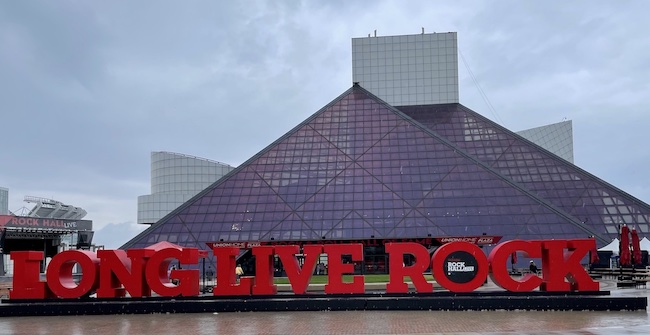
23 Comments
That group who had the 5,000 signature petition was probably The Moody Blues. I remember a few years of fellow fans’ angst every time possible inductees were announced.
You are correct!
Even though it took waaay to long to induct the Moodies, it’s kind of hard to fathom how this high-horse R&RHOF “committee” could actually initially scoff at inducting the Moody Blues, especially since they were so original, had hits, and changed the realms of rock music with their use of orchestral sounds woven into their music, by making a formally unknown instrument so influential that even The Beatles created hits with it. I believe the Brits would rightfully call these committee members “wankers.”
I was going to say KISS.
They are already in.
An enjoyable read, with deserved criticism laid out upfront.It was ensuring to me anyway that your convictions towards the “Rock N’ Roll N’Shrine Circus” would carry through to the end, and not waver. I can vaguely remember being deluged with mail offers to join up in membership to the club when they were starting out.
I must have thought it was a good idea at the time,because I sent them money a couple times as dues, and in return received bumper stickers and t-shirts.I stopped then. As years passed it became apparent that this was turning into a corporate takeover, with the reek of politics stinking the air. So and so didn’t get in, but so and so did.
In another aspect, Steve Miller told them what they needed to hear, didn’t he? To round this out, I submit to you, Mr. Jeff Tamarkin, a petition signed by 1, me for the inclusion onto your third 100 list the greatest Rock group ever – GOLDEN EARRING.
Hey Jeff, thanks for this. Mesmerizing, and much needed, in so many ways. Why not publish the article you wrote about the nominations, that got you kicked out? I’d love to read that! Please keep up the good work.
I don’t have it anymore. It was nearly 30 years ago. Thanks for your comments.
Jeff–Congrats on finally making it to Cleveland for the visit. It’s not really a rock hall anymore–‘music hall’ would be appropriate. Yet, the permanent and many of the temp exhibits over the years have been really well done–we needed someplace to display all this great memorabilia. Where else are you going to see Quicksilver’s John Cipollina’s totally crazy amp set up? My most memorable? The temp Lennon exhibit, with John’s bloodied glasses and a white phone that Yoko would call every once in a while to chat with visitors. Haunting and deeply moving. So much to see. Totally agree about the dismembered politics from NYC–you experienced that first hand. Why Cleveland? I grew up there, yet I think Detroit should be its home, but the city and its many devoted rock fans wanted it more than anywhere else–and frankly, the city needed it more than any place else, except maybe Detroit. Great place for a visit. Lots to see. Good tourist attraction. But rock will always be about the clubs, the garages and the many nights alone with a guitar in hand and headphones on. The dream lives on.
I always called it the Rolling Stone Hall of Shame. It sounds like that was pretty close to the truth.
“Equity”? No thanks and God Bless America.
When Madonna, NWA, and ABBA are in the Rock ‘n Roll Hall of Fame, then the institution’s title is a misnomer. It’s not the pop and rap hall of fame, people. You don’t see rappers and pop singers in the Country Music Hall of Fame, do you? Figure it out, Jann Wenner.
Agree with the Rebellion reference. Rebellion against parents, Vietnam War, Richard Nixon and numerous others. The other thing about Rock N Roll ( That should be the way it’s spelled because that’s how we say it) lots of bands were formed to make some money and meet girls. So like it or not – Sex, Drugs and Rock N Roll.
To me the hall always epitomized ” We’re so happy we can hardly count” Wankers one and all.
Sounds like the rolling history of the Georgia Music Hall of Fame.
I provided them the Muddy Waters signature but did not receive any passes or for that manner even a thank you.
It’s wonderful that you made it to the Rock Hall a it stands in all of its glory. I’ve said it before on several sites that a friend and I visited it the year it opened. It was a disaster to say the least. I’m sure that it’s improved greatly but it was woefully pathetic then. When we were ready to leave, one of the girls in the front selling tickets asked if we enjoyed ourselves. I said “No, this place is a miserable mess.” A supervisor overheard me and stopped us. He asked what was wrong and I gave him an earful about the awful way things were set up. I got our money back and we went to a decent restaurant for a good meal. From what I’ve heard lately, things have improved greatly so, humbly, I will take some credit for what I told them. You’re welcome! Long live real R&R!
Been there, done that. The place is a joke. It deserves the name, The Rock + Roll Hall of shame. When Eminem gets in in his first year of eligibility and one of greatest lead singer / songwriters in rock history, Paul Rodgers, has never even been nominated you get the entire drift. The place sucks. I won’t ever go back.
Just to reiterate, the museum in Cleveland is almost a separate entity from the nominating committee in NYC that decides who might get inducted. The only real crossover is the room in the Cleveland HoF building where they display plaques of the people who’ve been inducted.
I will never spend a dime on this horrific place. That is also rock and roll!
I was there just before you, in June 2021. I left after one hour. I was appalled by the Super Bowl display, and generally felt the exhibits not very interesting. It was a surprise to see a Rory Gallagher guitar displayed and I liked that there was a display/tribute to local Cleveland rocker Michael Stanley, who passed not long before that. A sibling went there and spent over four hours. I thought the Country Music Hall of Fame in Nashville was far more worthwhile.
Thanks, Jeff. For speaking for me and about a zillion others of that “certain age group” who does not agree with the ethos of this hollow hall. But if you’re ever in Seattle, the Museum of Pop Culture is much more on target. And truer to what its name should reveal.
I’ve been there twice and it’s pretty well thought out and has some great exhibits but it’s just truly frustrating that certain acts that are almost no-brainers are still not in-I’m talking about Grand Funk or Jethro Tull or Emerson Lake and Palmer huge acts that sold millions of albums and filled stadiums and were an Intregal part of many peoples lives, including myself in the 60s and 70’s
sure everybody gripes about certain bands but some are just so obvious it’s almost absurd that they’re not at least nominated while other so-called rock acts that definitely are not rock are in such as all the rap and hip-hop artists etc